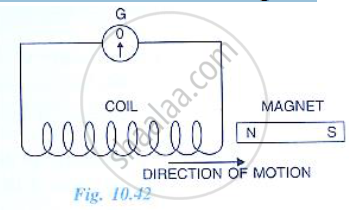Advertisements
Advertisements
Question
A transformer lowers e.m.f. 220 V to 12 volts. If the number of turns in primary are 8800, how many turns are in secondary coil?
Solution
Using `"E"_"p"/"E"_"s" = "N"_"p"/"N"_"s"`
∴ `"200 V"/"12 V" = 8800/"N"_"s"`
∴ `"N"_"s" = (8800 xx 12)/220 = 40 xx 12 = 480`
∴ Number of turns in secondary coil = 480.
APPEARS IN
RELATED QUESTIONS
A power transmission line feeds input power at 2200 V to a step-down transformer with its primary windings having 300 turns. Find the number of turns in the secondary to get the power output at 220 V.
How much current is drawn by the primary of a transformer connected to 220 V supply when it delivers power to a 110 V − 550 W refrigerator?
Explain why an induced current must flow in such a direction so as to oppose the change producing it.
The following diagram in Fig.10.42 shows a coil of several turns of copper wire connected to a sensitive centre zero galvanometer G near a magnet NS. The coil is free to move in the direction shown in the diagram.

(i) Describe the observation if the coil is rapidly moved.
(ii) How would the observation be altered if (a) the coil has twice as many turns (b the coil was made to move three times as fast?
How are the e.m.f in the primary and secondary coils of a transformer related with the number of turns in these coils?
State the factors on which the frequency of the alternating e.m.f. depends.
Read the following paragraph and answer the question:

Long distance power transmissions
The large-scale transmission and distribution of electrical energy over long distances is done with the use of transformers. The voltage output of the generator is stepped up. It is then transmitted over long distances to an area sub-station near the consumers. There the voltage is stepped down. It is further stepped down at distributing sub-stations and utility poles before a power supply of 240 V reaches our homes.
Which of the following statement is true?
For an LCR circuit, the power transferred from the driving source to the driven oscillator is P = I2Z cos φ.
- Here, the power factor cos φ ≥ 0, P ≥ 0.
- The driving force can give no energy to the oscillator (P = 0) in some cases.
- The driving force cannot syphon out (P < 0) the energy out of oscillator.
- The driving force can take away energy out of the oscillator.
For what purpose are the transformers used?
